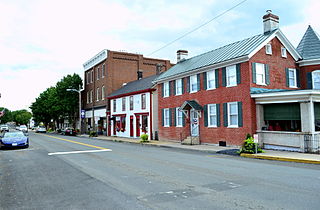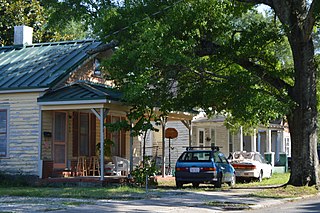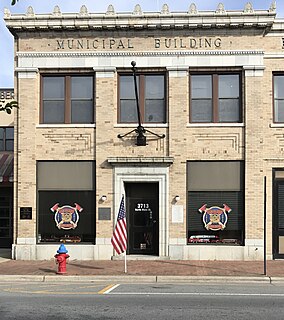
Strasburg Historic District is a national historic district located at Strasburg, Shenandoah County, Virginia. The district encompasses 206 contributing buildings and 1 contributing site in the town of Strasburg. It includes a variety of commercial, residential, and institutional buildings dating from the 18th to 20th centuries. Notable buildings include the George Eberly House, Presbyterian Church, Alton House, Spengler Hall, Spengler's Mill (1794), Bell Pottery (pre-1878), Strasburg Christian Church, Strasburg Methodist Church (1905), St. Paul's Lutheran Church (1892), First National Bank, Home Theatre (1930s), Strasburg School (1910) and the Sonner House (1757).

Oakwood Historic District is a national historic district located at Hickory, Catawba County, North Carolina. It includes work designed by architects Wheeler & Stearn. It encompasses 50 contributing buildings, 1 contributing site, and 1 contributing structure in an upscale residential section of Hickory. It includes notable examples of Colonial Revival, Bungalow / American Craftsman, and Queen Anne style architecture dating from the 1880s to 1930s. Notable buildings include the Robert E. Simpson House (1922), Walker Lyerly House (1913), Cline-Wilfong House (1912), Abel A. Shuford, II House, Paul A. Setzer House (1927), John H. P. Cilley House (1912), (first) Charles H. Geitner House (1900), Benjamin F. Seagle House, David L. Russell House, Robert W. Stevenson House, Jones W. Shuford House (1907), Dr. Robert T. Hambrick House (1928), Alfred P. Whitener House, and J. Summie Propst House (1881-1883).

Sutton Downtown Historic District is a national historic district located at Sutton, Braxton County, West Virginia. It encompasses 85 contributing buildings and two contributing structures covering eleven square blocks. The district includes the commercial, ecclesiastical, and civic core of the town and surrounding residential area. The district includes a number of buildings representative of popular architectural styles from the late-19th century and early-20th century including Romanesque Revival, Colonial Revival, Gothic Revival, and Greek Revival. Notable buildings include the Braxton County Courthouse (1881-1882) and Jail (1905), Sutton Bank Building (1891), Farmers Bank and Trust (1909), Bank of Sutton, Methodist Episcopal Church, South (1896), Kelly / Fisher House. Elk / Midway Hotel (1894), and Katie B. Frame Residence. The two structures are the Bridge over Old Woman Run (1892) and Bridge over Elk (1930).

North Main Avenue Historic District is a national historic district located at Newton, Catawba County, North Carolina. The district encompasses 86 contributing buildings in a primarily residential neighborhood of Newton. Most of the buildings date from the late-19th an early-20th century and includes notable examples of Colonial Revival and Bungalow / American Craftsman style architecture. Notable buildings include the Junius R. Gaither House, First Presbyterian Church (1878), Eli M. Deal House (1904), Wade C. Raymer House (1923), William W. Trott House, Dr. Glenn Long House, Hewitt-McCorkle House (1920), Andrew J. Seagle House, Walter C. Feimster House (1908), Robert B. Knox House (1912), (Former) Newton High School, Henkel-Williams-White House, Loomis F. Klutz House, (former) Newton Elementary School, and Beth Eden Lutheran Church (1929).

John Henry Kapp Farm is a historic farm complex and national historic district located near Bethania, Forsyth County, North Carolina. The district encompasses seven contributing buildings, one contributing site, and four contributing structures dated between about 1870 and 1942. They include a two-story, frame, vernacular I-house ; smokehouse; storage shed ; shop ; chicken house (1920s); corn crib / granary; barn (1870s); fence ; corn crib / granary ; tenant house ; tobacco pack house ; and the agricultural landscape.

Benson Historic District is a national historic district located at Benson, Johnston County, North Carolina. It encompasses 104 contributing buildings in the town of Benson. It includes notable examples of Late Victorian and Bungalow / American Craftsman style architecture and buildings dating from about 1900 to 1930. It includes commercial, residential, ecclesiastical, and educational structures. Notable buildings include the Farmers Commercial Bank (1921), C. T. Johnson Building (1910), James E. Wilson Livery Stable· and Store, Carolina-Parrish Hotel, Boon-Lawhorn House, Lonnie Stevens House, Dr. Parker-Allen House, Baptist Church (1914-1915), United Methodist Church (1917), and Benson Elementary School.

West Selma Historic District is a national historic district located at Selma, Johnston County, North Carolina. It encompasses 217 contributing buildings, 1 contributing site, and 1 contributing structures in predominantly residential section of Selma. It includes notable examples of Queen Anne, Gothic Revival, Moderne, and Bungalow / American Craftsman style architecture and buildings dating from about 1880 to 1961. Located in the district is the separately listed Nowell-Mayerburg-Oliver House and William E. Smith House. Other notable buildings include the Edgerton Memorial Methodist Episcopal Church, Abdalla House, Dr. Joshua W. Vick House, Stella and William H. Etheridge House, Dr. R. Marvin Blackmon House, Samuel P. Wood House (1935), Janie and C. E. Kornegay House (1923), Selma Presbyterian Church, St. Gabriel's Episcopal Church/Vernon Wiggs House, and Pepsi Bottling Company.

Lincolnton Commercial Historic District is a national historic district located at Lincolnton, Lincoln County, North Carolina. It encompasses 62 contributing buildings and 2 contributing objects in the central business district of Lincolnton. It includes a variety of commercial, institutional, and industrial buildings dating between about 1900 and 1955. Located in the district are the separately listed Classical Revival style Lincoln County Courthouse and First United Methodist Church. Other notable buildings include the Frank Beal House, Karl L. Lawing House, Reinhardt Building, Carolina First National Bank, Central Candy and Cigar Company, Jonas Building, Wampum Department Stores, Rhodes and Corriher Company building, and Coca-Cola Bottling Company building.

Nashville Historic District is a national historic district located at Nashville, Nash County, North Carolina. It encompasses 142 contributing buildings and 3 contributing structures in the rural county seat of Nashville. The buildings primarily date between 1890 and 1930, and include notable examples of Greek Revival, Italianate, Queen Anne, Colonial Revival, and Classical Revival style architecture. Located in the district are the separately listed Bissette-Cooley House and Nash County Courthouse. Other notable buildings include Joyner's Recreation, Graphic Building, Baldy Batchelor Livery Stable, Weldon's Department Store (1913), Nashville Fire Department (1930), Ricks-Strickland House (1890s), Squire Harper House (1868), two metal-veneered "Lustron houses," Neville-Strickland House (1907), Primitive Baptist Church, First Methodist Church (1923), and former Baptist Church.

Richlands Historic District is a national historic district located at Richlands, Onslow County, North Carolina. The district encompasses 90 contributing buildings, 2 contributing structures, and 2 contributing objects in the central business district and surrounding residential sections of Richlands. The district largely developed after 1880 and includes notable examples of Late Victorian and I-house style residential architecture. Notable contributing buildings include the Robert D. Thompson House (1908), Daniel Webster Murrill House (1908), the Del Barbee House (1910), the Edwards-Cox House (1915), Isaac Koonce House (1918), George Brooks House (1915), Franck House (1914), Richlands Theater (1936), J. F. Mohn Building (1936), Richlands Supply Company Building (1905), M. B. Steed Store (1911), Peoples Bank Building, Bank of Richlands (1927), First Baptist Church (1920s), and Richlands United Methodist Church (1939).

Hertford Historic District is a national historic district located at Hertford, Perquimans County, North Carolina. The district encompasses 219 contributing buildings, 2 contributing sites, 1 contributing structure, and 1 contributing object in the central business district and surrounding residential sections of Hertford. The district developed between about 1759 and 1948, and includes notable examples of Federal, Greek Revival, and Gothic Revival style architecture. Located in the district are the separately listed Perquimans County Courthouse and Church of the Holy Trinity. Other notable buildings include the Creecy-Skinner-Whedbee House, Edward Wood House, Matthews-Jacocks House, Temperance Hall (1851), Matthew H. White House, Dr. Thomas S. McMullan House (1905), Thomas Nixon House, William M. Divers House (1924), W.R. Shannonhouse Building (1895), Darden Department Store, Farmers National Bank of Hertford (1916), State Theatre (1937), Old Hertford Post Office (1915), Hertford Baptist Church (1854), and Hertford United Methodist Church (1901).

Farmville Historic District is a national historic district located at Farmville, Pitt County, North Carolina. The district encompasses 330 contributing buildings, 1 contributing site, and 2 contributing structures in the central business district and surrounding residential sections of Farmville. It includes buildings dated from about 1860 to 1942 and notable examples of Colonial Revival, Classical Revival, and Queen Anne style architecture. Notable buildings include the James W. May House, Fields-Rasberry House, Dr. David Morrill House, Warren Parker House, Nannie Smith House, First Christian Church (1910), Emmanuel Episcopal Church (1920), St. Elizabeth Catholic Church, Municipal Building (1928) possibly designed by Benton & Benton, Bank of Farmville (1921) designed by Benton & Benton, Pollard Auto Company Building, Paramount Theatre (1930s), J. Y. Monk Tobacco Warehouse, and East Carolina Railway Office and Freight Station.

Saluda Main Street Historic District is a national historic district located at Saluda, Polk County, North Carolina. The district encompasses 16 contributing buildings, 1 contributing site, and 1 contributing structure in the central business district of Saluda. It includes buildings dated from about 1878 to 1946 and notable examples of Late Gothic Revival and Stick style / Eastlake Movement architecture. Notable buildings include the Saluda Presbyterian Church (1895-1896), former Saluda Depot, the Saluda City Hall (1896-1907), the M. A. Pace Store (1905-1910), Thompson's Store (1905-1910), Pebbledash Building (1911-1916), Top Service Station (1930s), and the former United States Post Office.

Reidsville Historic District is a national historic district located at Reidsville, Rockingham County, North Carolina. It encompasses 324 contributing buildings, 1 contributing site, 11 contributing structures, and 1 contributing object in the central business district and surrounding residential sections of Reidsville. It was developed between about 1865 and 1941, and includes notable examples of Italianate, Queen Anne, American Craftsman, and Classical Revival style architecture. Located in the district are the separately listed Penn House and Gov. David S. Reid House. Other notable buildings include the Oaks-Motley House, Colonel A. J. Boyd House (mid-1870s), Reid Block (1880s), Citizens' Bank Building, William Lindsey and company Tobacco Factory, First Baptist Church, Main Street Methodist Church, Melrose (1909) designed by architect Richard Gambier, R. L. Watt house designed by Willard C. Northup, First Presbyterian Church (1922), St. Thomas Episcopal Church, Grand Theatre, Belvedere Hotel, United States Post Office and Federal Building, and the Municipal Building (1926).

Mount Airy Historic District is a national historic district located at Mount Airy, Surry County, North Carolina. The district encompasses 187 contributing buildings in the central business district and surrounding industrial and residential sections of Mount Airy. They were primarily built between about 1880 and 1930 and include notable examples of Late Victorian and Bungalow / American Craftsman architecture. Located in the district are the separately listed W. F. Carter House and Trinity Episcopal Church. Other notable buildings include the Abram Haywood Merritt House (1902), William A. Estes House, Thomas Fawcett House, J. D. Sargent House (1919), Campbell A. Baird House (1913), T. Benton Ashby House, First Baptist Church (1906-1912), Mount Airy Friends (1904), Presbyterian Church (1907-1914), Merritt Building, Banner Building (1906), Prather Block, Midkiff Hardware Store, Welch Block, West Drug Store, Belk's Building, (former) Workman's Federal Savings and Loan, (former) First National Bank (1893), Bank of Mount Airy (1923), U.S. Post Office (1932-1933), and the Sparger Brothers Tobacco Factory.

Henderson Central Business Historic District is a national historic district located at Henderson, Vance County, North Carolina. It encompasses 91 contributing buildings and 1 contributing structure in the central business district of Henderson. The district developed between about 1881 and 1937 and includes notable examples of Romanesque Revival and Classical Revival architecture styles. Located in the district are the separately listed Henderson Fire Station and Municipal Building, Vance County Courthouse, and Zollicoffer's Law Office. Other notable buildings include the (former) First National Bank (1921), Davis Department Store, P. H. Rose Building, Gaston Railroad Depot, Pogue's Tobacco Works, J, A. Kelly Tobacco Prizehouse, (former) H. Leslie Perry Public Library, (former) United States Post Office (1911) designed by the Office of the Supervising Architect under James Knox Taylor, O'Neil Building, First United Methodist Church (1930), Holy Innocents Episcopal Church, and First Presbyterian Church.

Mount Olive Historic District is a national historic district located at Mount Olive, Wayne County, North Carolina. The district encompasses 465 contributing buildings, 2 contributing structures, and 1 contributing object in the central business district and surrounding residential sections of Mount Olive. It developed between about 1838 and 1949, and includes notable examples of Italianate and Queen Anne style architecture. Located in the district are the separately listed former United States Post Office, Mount Olive High School (Former), Southerland-Burnette House, and Perry-Cherry House. Other notable contributing buildings are the Elms, Mount Olive Presbyterian Church (1916), Carver High School (1941), Wooten & Brothers Building, DeBrutz English House, Center Theatre (1947), Mount Olive Manufacturing Company (1914), Farrior-Wooten House, Mount Olive First United Methodist Church (1911-1913), Mt. Olive Pickle Co. Office (1920), Mount Olive Passenger Depot, and Ebenezer Apostolic Holiness Church (1850).

Lucama Municipal Historic District is a national historic district located at Lucama, Wilson County, North Carolina. It encompasses 42 contributing buildings in the railroad town of Lucama. The district developed between about 1890 to 1930 and includes notable examples of Classical Revival, Bungalow / American Craftsman, and Victorian style architecture. Notable buildings include the Will Davis Store, Jesse Lucas Store, Lucama Depot (1905), Kinchen Barnes Store, W. J. Newsome Store, Lousetta Newsome House (1887), Dr. Ben Hackney House, and Lucama Methodist Church (1915).

Fayette Residential Historic District is a national historic district located at Fayette, Howard County, Missouri. The district encompasses 308 contributing buildings and 2 contributing structures in a predominantly residential section of Fayette. It developed between about 1832 and 1956 and includes representative examples of Gothic Revival, Italianate, and Queen Anne style architecture. Located in the district is the separately listed Coleman Hall. Other notable buildings include the Hampton L. Boon House / George Carson House, W. W. Blakemore House, John Sears House / John B. Clark House, McKinney Sisters House, Tully Chenowith House, Methodist Episcopal Parsonage, T. A. F. Mitchell House, Oliver H. P. Corprew House (1880s), Huntington Hall, A. F. Davis House (1880-1884), R. Lee Maupin House (1905), Mrs. John H. Farrington House, the Daly School (1924), the T. A. Grigsby Building, and St. Joseph's Catholic Church (1956).

Commercial Community Historic District is a national historic district located at Lexington, Lafayette County, Missouri. The district encompasses 106 contributing buildings and 1 contributing structure in the central business district and surrounding residential area of Lexington. It developed between about 1830 and 1930, and includes representative examples of Late Victorian and Gothic Revival style architecture. Located in the district is the separately listed Lafayette County Courthouse. Other notable buildings include the Lexington Racquetball Club, Missouri Public Service Storage Building, Franklin Diner, Wright House, Goehner's Marbleworks, First Presbyterian Church, Municipal Auditorium (1930), Leiter Apartments, Lafayette County Sheriff's Office and Jail (1939), Morrison Wentworth Bank Building, and Winkler Theatre.




















